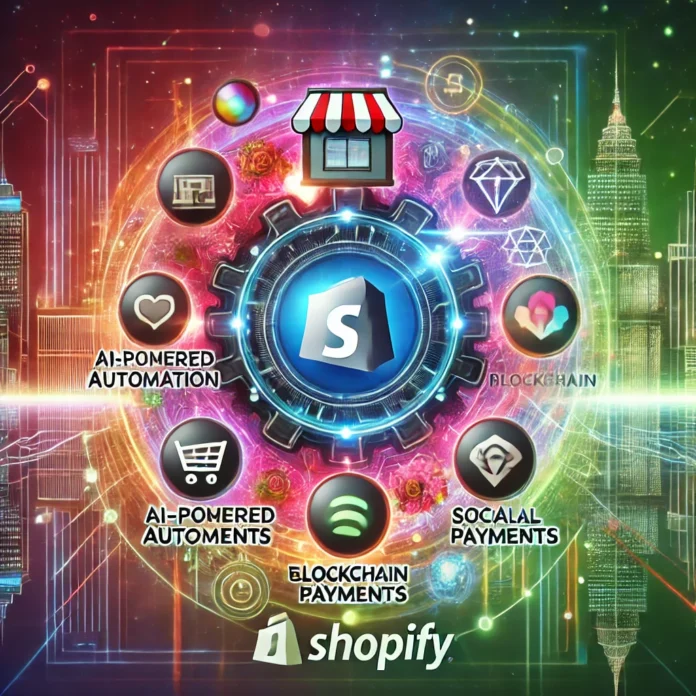The Future of Shopify What’s Next for E-Commerce?
Introduction
Shopify has revolutionized e-commerce, empowering millions of businesses to create online stores with ease. From small entrepreneurs to global brands, Shopify has become a dominant force in digital retail. But as technology evolves and consumer behavior shifts, what does the future hold for Shopify? Will it continue to lead the way in online commerce, or will new competitors challenge its reign?
In this article, we will explore the key trends shaping the future of Shopify and how the platform is adapting to the changing landscape of e-commerce.

1. The Rise of AI and Automation
Artificial Intelligence (AI) is transforming e-commerce, and Shopify is actively integrating AI-driven features to enhance the user experience. Some future developments may include:
- AI-powered chatbots: Shopify has already introduced AI-driven customer support solutions like Shopify Inbox. Expect more sophisticated AI chatbots that provide real-time customer support, recommend products, and handle returns automatically.
- Automated inventory management: AI-driven stock predictions will help merchants maintain optimal inventory levels, reducing losses due to overstocking or stockouts.
- Personalized shopping experiences: AI will refine customer segmentation, enabling Shopify store owners to offer hyper-personalized product recommendations and marketing campaigns.
AI-driven automation will streamline operations, allowing businesses to scale faster while minimizing manual tasks.
2. The Expansion of Shopify into Social Commerce
Social media platforms are becoming the new storefronts, and Shopify is positioning itself to capitalize on this trend. With integrations into Facebook, Instagram, TikTok, and Pinterest, Shopify merchants can sell directly through social media channels.
In the future, Shopify may:
- Expand its partnership with platforms like YouTube and WhatsApp for seamless shopping experiences.
- Improve AI-driven ad targeting to help store owners reach the right audience.
- Enhance live shopping features, allowing influencers and brands to sell in real-time via social platforms.
As younger consumers increasingly shop through social media, Shopify’s social commerce tools will become essential for business growth.
3. Shopify and the Future of Headless Commerce
Headless commerce—where the front-end (storefront) is separated from the back-end (e-commerce system)—is gaining traction. Shopify has already introduced Hydrogen and Oxygen, its solutions for headless commerce.
In the coming years, we can expect:
- More flexible store designs with customizable user experiences.
- Faster load times and better performance, leading to higher conversion rates.
- Increased adoption by large-scale enterprises looking for scalable e-commerce solutions.
Headless commerce will give Shopify merchants more creative control while maintaining the platform’s powerful backend infrastructure.
4. Cryptocurrency and Shopify Payments
As digital payments evolve, Shopify is likely to embrace blockchain technology and cryptocurrency payments. Some potential developments include:
- Increased support for crypto payments through Shopify Payments, allowing businesses to accept Bitcoin, Ethereum, and stablecoins.
- NFT commerce expansion, where merchants can sell digital collectibles directly from their stores.
- More partnerships with blockchain-based payment processors for faster and more secure transactions.
The integration of blockchain into Shopify could redefine trust, security, and transaction speed in e-commerce.
5. Sustainability and Ethical Commerce
Consumers are increasingly conscious of sustainability, and Shopify is making moves to support eco-friendly businesses. Shopify’s Planet App already allows merchants to offer carbon-neutral shipping.
Future initiatives may include:
- More robust supply chain transparency tools to verify ethically sourced products.
- Greater incentives for businesses that adopt sustainable packaging and production methods.
- Expansion of Shopify’s climate-conscious funding to support green initiatives.
With sustainability becoming a key purchasing factor, Shopify will likely strengthen its position as an ethical commerce leader.

6. Shopify’s Expansion into B2B E-Commerce
While Shopify has traditionally focused on direct-to-consumer (DTC) businesses, it is now expanding into business-to-business (B2B) commerce. The Shopify Plus B2B feature already allows wholesalers and enterprise clients to manage bulk orders efficiently.
In the future, we might see:
- More automation for bulk pricing and inventory management.
- Deeper integration with enterprise resource planning (ERP) systems to streamline large-scale operations.
- Enhanced B2B marketplaces powered by Shopify, where businesses can trade directly with each other.
This shift will allow Shopify to compete with platforms like Alibaba and Amazon Business.
7. The Rise of Subscription-Based Commerce
Subscription models are booming, and Shopify is enhancing its capabilities to support businesses that rely on recurring revenue. The Shopify Subscriptions API is a step toward a more seamless experience for subscription-based businesses.
Looking ahead, Shopify may:
- Introduce built-in subscription management tools for merchants.
- Improve integration with loyalty programs and rewards systems to increase customer retention.
- Offer AI-driven subscription predictions, allowing businesses to forecast future sales based on customer behavior.
With more consumers preferring subscription-based shopping, Shopify will likely enhance its tools to help businesses succeed in this space.
8. Shopify vs. Amazon: The Battle for E-Commerce Supremacy
Shopify and Amazon have long been competing for dominance in online retail. Shopify’s key advantage lies in its ability to empower independent businesses, while Amazon focuses on its marketplace model.
Future developments in this competition may include:
- Shopify launching its own fulfillment network to rival Amazon’s fast shipping.
- A greater push toward direct-to-consumer (DTC) branding, giving merchants more control over their customer relationships.
- More AI-driven analytics tools to help Shopify businesses make data-driven decisions.
If Shopify successfully strengthens its logistics and fulfillment services, it could provide a real alternative to Amazon for independent sellers.

Conclusion
The future of Shopify is bright, with continuous innovation shaping the next era of e-commerce. From AI-driven automation to blockchain payments, social commerce, and sustainability initiatives, Shopify is adapting to emerging trends to remain a leader in online retail.
For entrepreneurs and businesses, staying ahead means embracing these technological advancements and leveraging Shopify’s evolving ecosystem to build a competitive edge.


